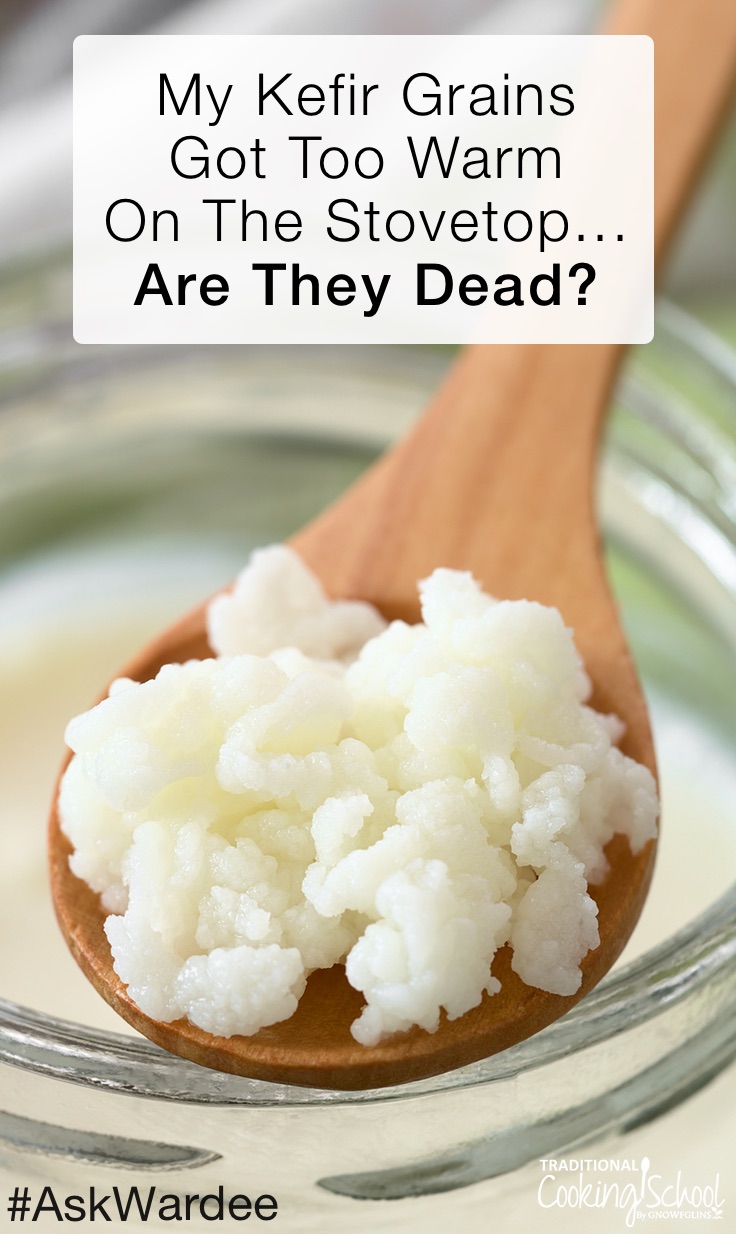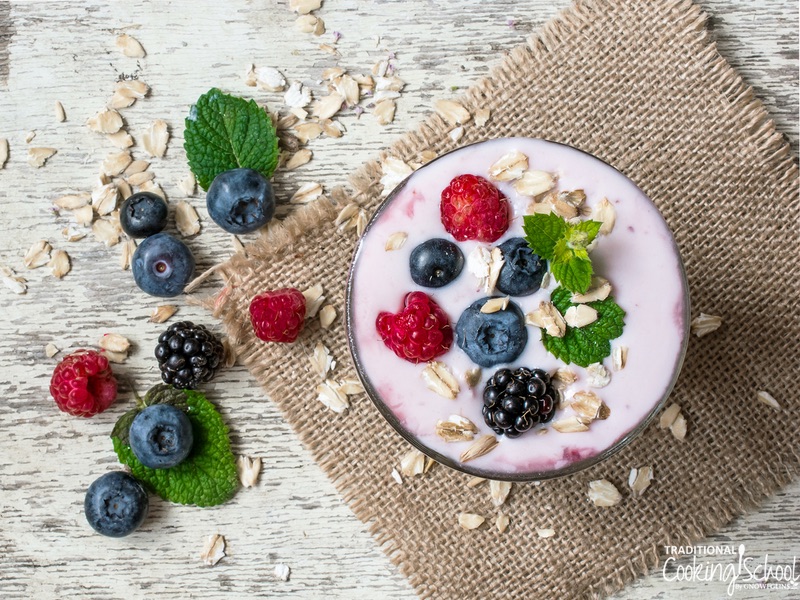
It’s happened to most of us…
…we left a culture in or on the oven or stove.
The oven or stove gets turned on and … oh, boy! Oops!
If it’s kefir, you’ll find curds and whey, a stronger taste than usual, and maybe a bit cheesy.
And what about the grains? Are they dead? Can they be saved?
That’s what we’re discussing on today’s #AskWardee. Check out the particulars below in print, podcast, or video.
Subscribe to #AskWardee on iTunes, Stitcher, YouTube, or the Podcasts app.
The Question: Her Kefir Grains Got Too Warm… Are They Dead?
Janet M. asked:
I have a friend who also started making her own kefir and she used to let her kefir ferment on her stove-top because it was warm. She forgot to take it off the stove-top while baking something in the oven and thinks it got too warm. The milk separated. After shaking it, it separated again, and didn’t taste right. She is wondering if kefir grains can get too warm and kill the bacteria?
My Answer: It Depends…
When heated, the kefir separates into curds and whey and may taste cheesy or “cooked”. And, the kefir grains may die. Excessive heat kills them.
It’s hard to know for sure what happened with your friend’s grains, Janet, because they weren’t in the oven. (That would be way too hot for sure).
For your friend or anyone else in this pickle — the grains got warmed up but we’re not sure if it was too warm —I suggest this:
Try making kefir again and see if the grains work or not.
Does the kefir turn out like it used to? If yes, they may have survived!
Are the grains shriveling away and appearing not to thrive — or do they maintain or keep growing? If the former, they’re dead and need to be replaced. If the latter, maybe they’re okay!
That’s a pretty short answer, but it’s a pretty simple issue.

What Is Kefir?
Kefir is a fermented dairy that’s similar to yogurt, except the mother culture is both beneficial bacteria and yeast. Yogurt is only beneficial bacteria.
The end result is thinner, more sour, and even a bit effervescent or bubbly, due to the organisms producing more gas as they culture the milk.
You can make kefir with raw or pasteurized milk. It’s easier than yogurt, actually. Here is my ULTIMATE Milk Kefir Guide to help you along the way.
Simply plop your culture (these dairy kefir grains) into a bit of milk, cover your jar, and let it culture at room temperature for 24 to 48 hours (adjusting up or down depending on the season of the year, temperature of your house, etc.).
Then, remove the grains and put them a new batch of milk. Cover and refrigerate the finished kefir.
By the way, if you want a good yogurt recipe… be sure to grab my free thick raw milk yogurt recipe. It uses the yogurt culture AND also keeps the culture that’s naturally present in the raw milk AND it stays nice and thick. (Most yogurt recipes use pasteurized milk; if one were to use raw milk instead, it would turn out runny.) Go here to get the free recipe!
You can check out the Cultured Dairy & Basic Cheese eCourse inside Traditional Cooking School or my Cultured Dairy & Basic Cheese eBook and Video Package to learn how to make kefir.
What Are Kefir Grains?
Kefir grains are the mother culture for making kefir. They are soft and rubbery and look a lot like clumps of cauliflower. You put them in milk and pull them out, and can reuse them over and over again. They also grow (some do, some don’t, it depends on the milk and conditions)… so you can share with friends or make more with your extra grains.
What’s in the grains, though? The beneficial yeasts and bacteria! They live in that rubbery, cauliflower-like matrix. When plopped into milk, they eat the lactose (milk sugar) and, in exchange, create the thickened, curdled, sour, bubbly milk we call kefir!
Kefir is full of probiotics and beneficial acids. It also has less lactose than milk. The longer it ferments, the more lactose is consumed.
These grains contain at least 30 beneficial strains of bacteria and yeast, making them a true probiotic power house!
Wondering where to get them? My favorite source are these Dairy Kefir Grains from Cultures For Health!
Helpful Links
- How To Make Milk Kefir (and why it’s so good for you)
- Free Thick Raw Milk Yogurt Recipe — it’s faster and easier than most recipes, and you can make it with pasteurized milk, too!
- Dairy Kefir Grains from Cultures For Health — my recommended source!
- #AskWardee 044: What’s the best cultured dairy for probiotics?
- Cultured Dairy & Basic Cheese eBook & Video Package
- Cultured Dairy & Basic Cheese eCourse (included with TCS membership)
- 8 Yummy Ways To Eat Kefir
- How To Make Thicker Milk Kefir
- Many of these probiotic salad dressings are made with kefir!
- Kefir Cheese Balls
Have you forgotten a culture in or on the oven? What happened?
We only recommend products and services we wholeheartedly endorse. This post may contain special links through which we earn a small commission if you make a purchase (though your price is the same).


Now I have a question. I recently started making kombucha. Am slowly replacing sugar with honey. I enjoy a cup every morning. My question, since the kombucha “mushroom” is yeast and bacteria, what is the difference between that and the kefir yeast and bacteria? Could I make kefir with one of my extra kombucha mushrooms?
Hi Lyn,
Great question! 🙂
Unfortunately, you cannot start kefir from your extra kombucha mushrooms. Kefir and kombucha are both colonies of bacteria and yeast however the strains of bacteria and yeasts are different.
~Danielle, TCS Customer Success Team
Question:
What do you pair cheese with in place of crackers? (Like soft, cultured cheeses) How do you eat them? What are some other traditional uses for cheese?
Also, what are so easy, yummy veggie side dishes?
Thanks!
Hi Mariah,
Homemade cheese is great paired with homemade bagels or grain-free crackers.
Here’s a link to our homemade bagels: https://traditionalcookingschool.com/2016/10/28/einkorn-sourdough-bagels/
Here are two grain-free cracker recipes: https://traditionalcookingschool.com/2015/08/18/green-plantain-crackers-and-resistant-starch/ and https://traditionalcookingschool.com/2012/07/02/grain-free-almond-sunny-seed-crackers/
You can find lots of yummy side dishes in our recipe archives which is located here: https://traditionalcookingschool.com/recipes/
~Danielle, TCS Customer Success Team
Crispy, roasted (cooled) garden veggies…tomato, sweet potato etc. Amazin’ !
Crispy, roasted (cooled) garden veggies…tomato, sweet potato etc. Amazin’ !
My kefir is producing whey, also I think the milk I used may not have been so fresh. Is this a sign that the grains are beginning to die… should I throw them away?
Hi, Theresa.
The separation, although not desirable is not a bad thing. 🙂 You can use the whey to make lacto-fermented veggies or other things.
Remove your grains to keep it from continuing to separate.
Then shake your kefir before you put it through a strainer. Once in the strainer, use a rubber spatula and stir it around so the whey will go through the strainer. You may want to add a piece of cheesecloth or a thin pillowcase to the strainer if the strainer has large holes.
Then feed your grains to get them started again 🙂
~Danielle, TCS Customer Success Team
Hello, I’ve been using the same keifer grains for several years now with great success but recently my grains are very small. They are not clumping together like they used to be and they are soft (not chewy like before). The keifer milk seems to be fermenting okay although it looks a little curdly… more so than at other times. Are my grains starting to die?
Hi, Linda.
Kefir grains can get smaller and/or not grow. The important thing is whether or not they are making kefir. And then if they are shrinking away to nothing, that would be a bad sign.
Could you change the milk? Maybe there’s something in the milk that’s bothering the grains.
~Danielle, TCS Customer Success Team
I have a question I bought some grains off etsy and put them in milk than strained them the next day I had stirred them that night they were in the milk but when I strained them they looked like powder or had fallen apart some were big grains I put them back into milk and they aren’t floating i see curds at the bottom of jar like grains or something happening but the top of it is just milk i think i killed these grains not sure what happening?
Hi, Ashley,
It could be you fermented too long or the temperature of your home is warm and it fermented quickly if the milk tastes very sour and it seperated. It could also be your milk source. Here is something that may help you: https://traditionalcookingschool.com/food-preparation/why-kefir/
We’ve been teaching TCS premium members how to make milk kefir at home for over a decade now and we are happy to get you more help if you are interested, here is more information on membership: https://traditionalcookingschool.com/lp/member/
~Peggy, TCS Customer Success Team